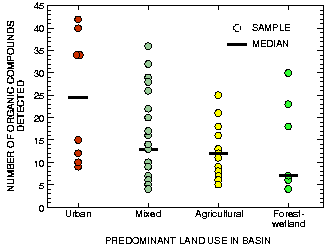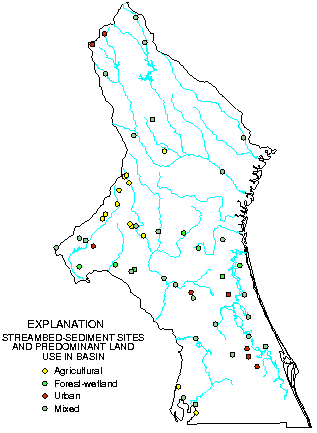Organic compounds and trace elements sorb onto streambed sediments and can persist in the environment for many years. Streambed sediments provide habitat for a wide variety of aquatic organisms. Excessive levels of these organic compounds and trace elements can be detrimental to aquatic organisms, causing tumors, suppression of growth, and changes in behavior, blood chemistry, and reproduction (U.S. Environmental Protection Agency, 1996).
Of the 24 organochlorine pesticides and 74 semivolatile organic compounds (SVOCs) analyzed in streambed-sediment samples from 54 sites, 12 organochlorine pesticides and 50 SVOCs were detected. The median number of organic compounds detected was considerably higher for samples from urban basins than for samples from any other land-use setting (see land-use classification of basins, p. 8). Most sampling sites were in basins of mixed land use, so assessing the source of the compounds was extremely difficult.

The median number of organic compounds detected was highest in streambed-sediment samples from urban basins.
Although most organochlorine pesticides are no longer used, they persist in streambed sediments and are potentially available for biological uptake. The DDT degradation product p,p´-DDE was detected in 45 percent of the samples, whereas p,p´-DDT was detected in 28 percent. Mirex was detected at 22 percent of sites and chlordane was detected at 26 percent of sites. Concentrations of one or more compounds exceeded aquatic-life criteria (Gilliom and others, in press) at 22 percent of sites, including chlordane at 11 sites; p,p´-DDE at 6 sites; and total DDT at 2 sites. None of the exceedances occurred in forest-wetland basins. Before chlordane was banned in 1987, it was widely used to kill termites and ants in dwellings and as an insecticide in agricultural areas (Barbash and Resek, 1996). DDT, a widely used pesticide for 30 years, was banned in the United States in 1972.

Streambed-sediment samples were collected in basins with a variety of land uses.
The most frequently detected SVOCs were chrysene, di-n-butyl-phthalate, bis (2-ethylhexyl) phthalate, phenol, fluoranthene, p-cresol, pyrene, benzo[b] fluoranthene, benzo[k] fluoranthene, benz[a] anthracene, and 2,6-dimethylnaphthalene. These compounds were detected in 52 to 94 percent of the streambed-sediment samples (p. 27-28). Phthalates are present in many plastic materials. Although a naturally occurring substance, phenol is used as a disinfectant and for making dyes and resins (Windholz and others, 1976). PCBs were detected in only one sample from an urban site near Atlanta, Ga., at concentrations that did not exceed aquatic-life criteria.
Last modified: April 14, 1998 10:45 am